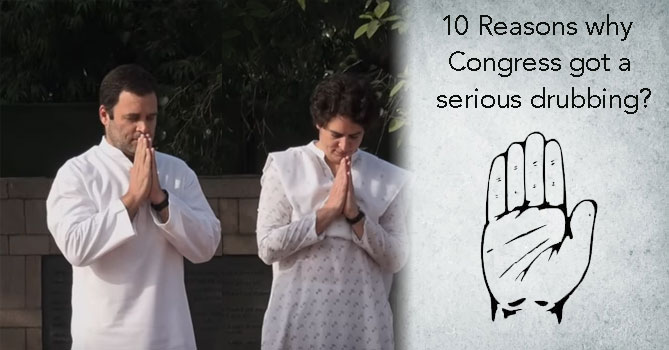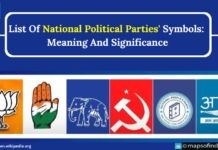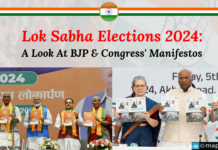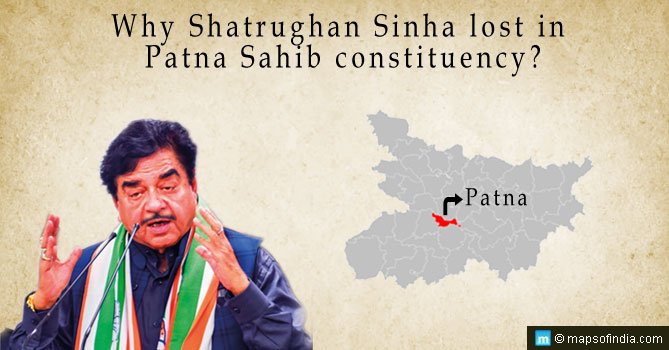
As citizens of India and voters, we can only speculate on the reasons for the drubbing the grand old party received in the 2019 General Elections. However, a closer examination will reveal certain shortcomings in Congress strategy.
-
The ‘Gandhi’ disadvantage
The Nehru-Gandhi family political legacy had evolved into a heirloom passing on from one generation to another, along with all the privileges associated with it. The Congress party has not been able to dissociate itself from the family, even as the family name transformed from an asset into a liability.
Rahul Gandhi became the Congress party president, not on merit or any specific qualification but because he happened to be born a Gandhi.
This fact was resented by many in the country. As Narendra Modi’s stature grew, Rahul Gandhi looked weaker. He could be the biggest factor for the massive defeat in 2014 and 2019.
-
Failure to learn from 2014 debacle
Any party suffering a massive defeat would seriously introspect and come up with innovative solutions to re-invent itself. Not the Congress. After much deliberation post-2014 results, the party decided to continue to promote Rahul Gandhi as the heir to his mother, Sonia Gandhi. Though he was formally appointed party president in 2017, people saw no hope for a revival under him.
-
The ‘PM’ challenger trap
The positioning of a weak and unsure Rahul Gandhi as the direct challenger to PM Modi was a mistake and a bad strategic move. Rahul Gandhi should not have repeatedly placed himself as the person taking on a giant. Instead, he should have focused on areas where the BJP was weak – economy, jobs, demonetization, high prices, etc. He started the campaign focusing on issues but soon fell for the PM ‘challenger’ trap. The gap was too wide to bridge.
-
Misplaced nationalism post-Pulwama
Nationalism and security are emotive issues uniting all Indians. Rahul Gandhi, along with the party leadership, completely missed this point. They needlessly questioned the authenticity of the surgical strike post-Uri attack, the Pulwama attack itself, and the subsequent Balakot strike on Pakistan. It did not go down well with the common man.
-
Lack of focus on anti-incumbency factors
The BJP-led NDA began losing ground and popularity with less than desired results relating to the economy. The economic growth was slowing down, new jobs grew to a trickle, and fuel prices went through the roof along with commodities. Agricultural distress was hitting the government hard, and ill-planned moves like demonetization hit the common man.
The Congress party failed to highlight these as the core points against the ruling NDA.
-
NYAY introduced too late
The social welfare scheme NYAY guaranteed Rs 6,000 per month into the accounts of the poorest. In a country where a large section of the population lives in abject poverty, NYAY was an unbeatable game changer and could have turned the tables on BJP. The scheme was well conceived but the party failed to communicate core benefits to the intended segment.
-
Failure to build confidence among minority groups
Congress has traditionally followed a pro-minority policy which at times was seen as appeasement by the opposition parties. BJP successfully raised ‘Secularism’ as a Congress bogey for appeasement. Repeated mentions forced Congress to take countermeasures by resorting to soft Hindutva, visiting temples and conducting rituals.
It failed to gain traction with either the Hindu community or the Muslim voters. Same with other minority groups like the Dalits and OBCs, who preferred steady governance of the BJP to an uncertain, and possibly, an unstable government under Congress-led UPA.
-
Poor organizational structure
After the 2014 debacle, the Congress failed to rebuild its already weak organizational structure, especially at the grassroots. Its workers remained confused about the core message, and vague on the path forward. It showed up in the aftermath of the initial success in assembly elections in Rajasthan, Chhattisgarh, and M.P. The party drew blank in the general elections.
-
Lack of inspiring leadership
Betting on Rahul Gandhi was a mistake, and he failed to provide inspiring leadership that would energize the length and breadth of the party. He was the reason which made the TINA factor so obvious for the BJP.
-
Failure to build and nurture alliances
For an old and experienced party like the Congress, it was disappointing to see them fail to build new alliances and nurture old ones. The alliances should have been stitched up at least a year before the elections, so that a united message could go out to the country. The challenge for Congress was that most parties viewed it as a liability rather than an asset.
Related Link:




